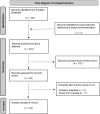Screening Health-Related Social Needs in Hospitals: A Systematic Review of Health Care Professional and Patient Perspectives
- PMID: 37092962
- PMCID: PMC10278007
- DOI: 10.1089/pop.2022.0279
Screening Health-Related Social Needs in Hospitals: A Systematic Review of Health Care Professional and Patient Perspectives
Abstract
Health outcomes are markedly influenced by health-related social needs (HRSN) such as food insecurity and housing instability. Under new Joint Commission requirements, hospitals have recently increased attention to HRSN to reduce health disparities. To evaluate prevailing attitudes and guide hospital efforts, the authors conducted a systematic review to describe patients' and health care providers' perceptions related to screening for and addressing patients' HRSN in US hospitals. Articles were identified through PubMed and by expert recommendations, and synthesized by relevance of findings and basic study characteristics. The review included 22 articles, which showed that most health care providers believed that unmet social needs impact health and that screening for HRSN should be a standard part of hospital care. Notable differences existed between perceived importance of HRSN and actual screening rates, however. Patients reported high receptiveness to screening in hospital encounters, but cautioned to avoid stigmatization and protect privacy when screening. Limited knowledge of resources available, lack of time, and lack of actual resources were the most frequently reported barriers to screening for HRSN. Hospital efforts to screen and address HRSN will likely be facilitated by stakeholders' positive perceptions, but common barriers to screening and referral will need to be addressed to effectively scale up efforts and impact health disparities.
Keywords: attitudes; health-related social needs; screening; social determinants of health.
Conflict of interest statement
Dr. Rajmane and Dr. Dankwa-Mullan were employees of IBM Corporation at the time this study was completed. All authors herein declare no conflicts of interest.
Figures
Similar articles
-
Health Related Social Needs Among Chinese American Primary Care Patients During the COVID-19 Pandemic: Implications for Cancer Screening and Primary Care.Front Public Health. 2021 May 28;9:674035. doi: 10.3389/fpubh.2021.674035. eCollection 2021. Front Public Health. 2021. PMID: 34123992 Free PMC article.
-
Critical Perspectives: Medical Social Workers' Early Insights on Health-Related Social Needs Screening and Follow-up.J Healthc Manag. 2025 May-Jun 01;70(3):205-219. doi: 10.1097/JHM-D-24-00039. Epub 2025 May 9. J Healthc Manag. 2025. PMID: 40358110
-
Screening for health-related social needs in the emergency department: Adaptability and fidelity during the COVID-19 pandemic.Am J Emerg Med. 2022 Apr;54:323.e1-323.e4. doi: 10.1016/j.ajem.2021.09.071. Epub 2021 Oct 1. Am J Emerg Med. 2022. PMID: 34654599 Free PMC article.
-
Pediatrics leading the way: co-enrollment as the next step in health-related social needs screening and referral.Curr Opin Pediatr. 2025 Feb 1;37(1):19-26. doi: 10.1097/MOP.0000000000001416. Epub 2024 Nov 12. Curr Opin Pediatr. 2025. PMID: 39699097 Review.
-
Geographically Indexed Referral Databases to Address Social Needs in the Emergency Department.West J Emerg Med. 2021 Mar 4;22(2):218-224. doi: 10.5811/westjem.2020.11.49250. West J Emerg Med. 2021. PMID: 33856303 Free PMC article.
Cited by
-
Barriers and facilitators to screen for and address social needs in primary care practices in Maryland: a qualitative study.Front Health Serv. 2024 Jun 17;4:1380589. doi: 10.3389/frhs.2024.1380589. eCollection 2024. Front Health Serv. 2024. PMID: 38952646 Free PMC article.
-
Identifying and addressing health-related social needs: a Medicaid member perspective.BMC Health Serv Res. 2024 Oct 8;24(1):1203. doi: 10.1186/s12913-024-11605-9. BMC Health Serv Res. 2024. PMID: 39379956 Free PMC article.
-
Precision Prevention: Using Data to Target the Right Intervention at the Right Intensity in the Right Community at the Right Time.Yearb Med Inform. 2024 Aug;33(1):6-17. doi: 10.1055/s-0044-1800713. Epub 2025 Apr 8. Yearb Med Inform. 2024. PMID: 40199283 Free PMC article.
-
Views and preferences of food-insecure pregnant women regarding food insecurity screening and support within routine antenatal care.Health Expect. 2024 Feb;27(1):e13956. doi: 10.1111/hex.13956. Health Expect. 2024. PMID: 39102650 Free PMC article.
-
Medically Tailored Grocery Deliveries to Improve Food Security and Hypertension in Underserved Groups: A Student-Run Pilot Randomized Controlled Trial.Healthcare (Basel). 2025 Jan 27;13(3):253. doi: 10.3390/healthcare13030253. Healthcare (Basel). 2025. PMID: 39942442 Free PMC article.
References
-
- Institute of Medicine Committee on Assuring the Health of the Public in the 21st Century. The future of the public's health in the 21st century. National Academies Press (US) Copyright 2003 by the National Academy of Sciences, Washington, DC, USA; 2002.
-
- Marmot M. The health gap: doctors and the social determinants of health. Scand J Public Health 2017;45:686–693. - PubMed
-
- Murray GF, Rodriguez HP, Lewis VA. Upstream with a small paddle: how ACOs are working against the current to meet patients' social needs. Health Aff 2020;39:199–206. - PubMed
-
- National Academies of Sciences. Integrating social care into the delivery of health care: moving upstream to improve the Nation's Health. National Academies Press (US) Copyright 2019 by the National Academy of Sciences, Washington, DC, USA; 2019. - PubMed
Publication types
MeSH terms
LinkOut - more resources
Full Text Sources
Medical

